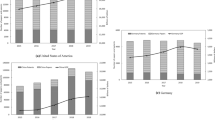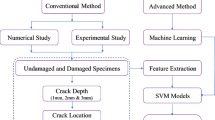Abstract
To improve the monitoring accuracy of grain loss sensors, an optimised structure for grain loss sensors was designed. First, stainless steel 304, copper plate and aluminum T6 were selected as potential materials for sensitive plates, and the collision signal characteristics with these different materials were studied in detail. Then, the relationship between the damping ratio and collision response was studied. The detection revolution was improved significantly by integrating viscoelastic damping layers into the sensitive plate. An optimal passive vibration isolation structure was designed to reduce the effect of vibrations on collision signals. Finally, field tests were performed, and the results revealed that the relative error was ≤ 3.46%.











Similar content being viewed by others
Data Availability
The datasets generated during and/or analysed during the current study are available from the corresponding author on reasonable request.
References
Bernhardt, G., & Hubner, R. (2002). Apparatus and method for determining grain loss in combine harvesters. United States Patent No., 2003(0199291), A1.
Carmen, W., Missotten, B., De Baerdemaeker, J., & Saeys, W. (2009). Hyperspectral waveband selection for on-line measurement of grain cleanness. Biosystems Engineering, 104, 1–7.
Craessaerts, G., Saeys, W., Missotten, B., & Baerdemaeker, J. D. (2008). Identification of the cleaning process on combineharvesters. Part I: a fuzzy model for prediction of the material other than grain (MOG) content in the grain bin. Biosystems Engineering, 101(1), 42–49.
Chen, B. Y., Ma, G. F., & Yan, H. Z. (2005). Study on the damping property of butyl rubber. World Rubber Industry, 32, 31–33.
Denning, B.K., Ziegler, D.H. (1985) Grain loss sensor mounting arrangement for a combine. United States patent No. 14517792 A.
Diekhans, N., Behnke, W. (1990) Lost-grain detector for harvesting machine. United States patent No. 4902264 A.
Fen, Y. C., Zhan, H., & Tang, S. M. (2011). Design for vibration control with constrained partial damping based on modal analysis. Ship Science and Technology, 11, 22–26.
Gelinske, J.N., Batcheller, B.D., Nystuen, P.A., Reich A.A., Thurow, B.R., Schleusner B.K.(2017) Acoustic material flow sensor, United States patent No. US9631964B2.
Lenaerts, B., Missotten, B., & De Baerdemaeker, J. (2012). LiDaR sensing to monitor straw output quality of a combine harvester. Computers and Electronics in Agriculture, 85, 40–44.
Li, Z. X., Ju, L. Y., Jiang, H., Xu, X., & Li, M. (2016). Experimental and simulation study on the vibration isolation and torsion elimination performances of interconnected air suspensions. Proceedings of the Institution of Mechanical Engineers, Part D: Journal of Automobile Engineering, 230(5), 679–691.
Liang, Z. W., Li, Y. M., Xu, L. Z., & Zhao, Z. (2017). Optimum design of an array structure for the grain loss sensor to upgrade its resolution for harvesting rice in a combine harvester. Biosystems Engineering, 157, 24–34.
Liu, C., & Leonard, J. (1993). Monitoring actual grain loss from an axial flow combine in real time. Computers and Electronics in Agriculture, 9, 231–242.
Mouazen, A. M., Anthonis, J., & Saeys, W. (2004). An automatic depth control system for online measurement of spatial variation in soil compaction, Part 1: Sensor design for measurement of frame height variation from soil surface. Biosystems Engineering, 89, 139–150.
Omid, M., Lashgari, M., & Mobli, H. (2010). Design of fuzzy logic control system incorporating human expert knowledge for combine harvester. Expert Systems with Applications, 37, 7080–7085.
Pan, X. Y., Shangguan, W. B., Chai, G. Z., & Huang, Z. (2009). An investigation of calculation methods for the dynamic characteristics of rubber isolator. Journal of Vibration Engineering, 22(4), 345–351.
Reyns, P., Missotten, B., Ramon, H., & De Baerdemaeker, J. (2002). A review of combine sensors for precision farming. Precision Agriculture, 3, 169–182.
Sciulli, D., & Inman, D. J. (1998). Isolation design for a flexible system. Journal of Sound and Vibration, 216(3), 251–267.
Trindade, M. A., & Benjeddou, A. (2002). Hybrid active-passive damping treatments using viscoelastic and piezoelectric materials: Review and assessment. Journal of Vibration Control., 8(6), 699–745.
Wang, Z., Che, D., Bai, X. P., & Hu, H. C. (2018). Improvement and experiment of cleaning Loss rate monitoring device for corn combine harvester. Transactions of the Chinese Society for Agricultural Machinery, 49(12), 100–108.
Xu, L. Z., Wei, C. C., Liang, Z. W., Chai, X. Y., Li, Y. M., & Liu, Q. (2019). Development of rapeseed cleaning loss monitoring system and experiments in a combine harvester. Biosystems Engineering, 178, 118–130.
Zhao, Z., Li, Y. M., Liang, Z. W., & Gong, Z. Q. (2013). DEM simulation and physical testing of rice seed impact against a grain loss sensor. Biosystems Engineering, 116(4), 410–419.
Zhao, Z., Li, Y. M., Liang, Z. W., & Chen, Y. (2012). Optimum design of grain impact sensor utilising polyvinylidene fluoride films and a floating raft damping structure. Biosystems Engineering, 112(3), 227–235.
Zhou, J., Cong, B. H., & Liu, C. L. (2014). Elimination of vibration noise from an impact-type grain mass flow sensor. Precision Agriculture, 15(6), 627–638.
Acknowledgments
This research was supported by the National Natural Science Foundation of China (51905221); the Natural Science Foundation of Jiangsu Province (BK20190859), China; Project funded by China Postdoctoral Science Foundation (2019M651746 & 2020T130260), China; The Natural Science Foundation of the Jiangsu Higher Education Institutions of China (19KJB210009), China; a Project Funded by Synergistic Innovation Center of Jiangsu Modern Agricultural Equipment and Technology (4091600027), China; a project for postdoctoral researchers in Jiangsu Province, China (2019Z106), Jiangsu Association of Science and Technology Young Talent Support Project (2020-21), and a Project Funded by the Priority Academic Program Development of Jiangsu Higher Education Institutions (No. PAPD-2018-87), China. Thanks for all your support.
Author information
Authors and Affiliations
Corresponding author
Ethics declarations
Conflict of interest
The authors declare no conflict of interest.
Additional information
Publisher's Note
Springer Nature remains neutral with regard to jurisdictional claims in published maps and institutional affiliations.
Rights and permissions
About this article
Cite this article
Liang, Z. Selecting the proper material for a grain loss sensor based on DEM simulation and structure optimization to improve monitoring ability. Precision Agric 22, 1120–1133 (2021). https://doi.org/10.1007/s11119-020-09772-w
Accepted:
Published:
Issue Date:
DOI: https://doi.org/10.1007/s11119-020-09772-w




